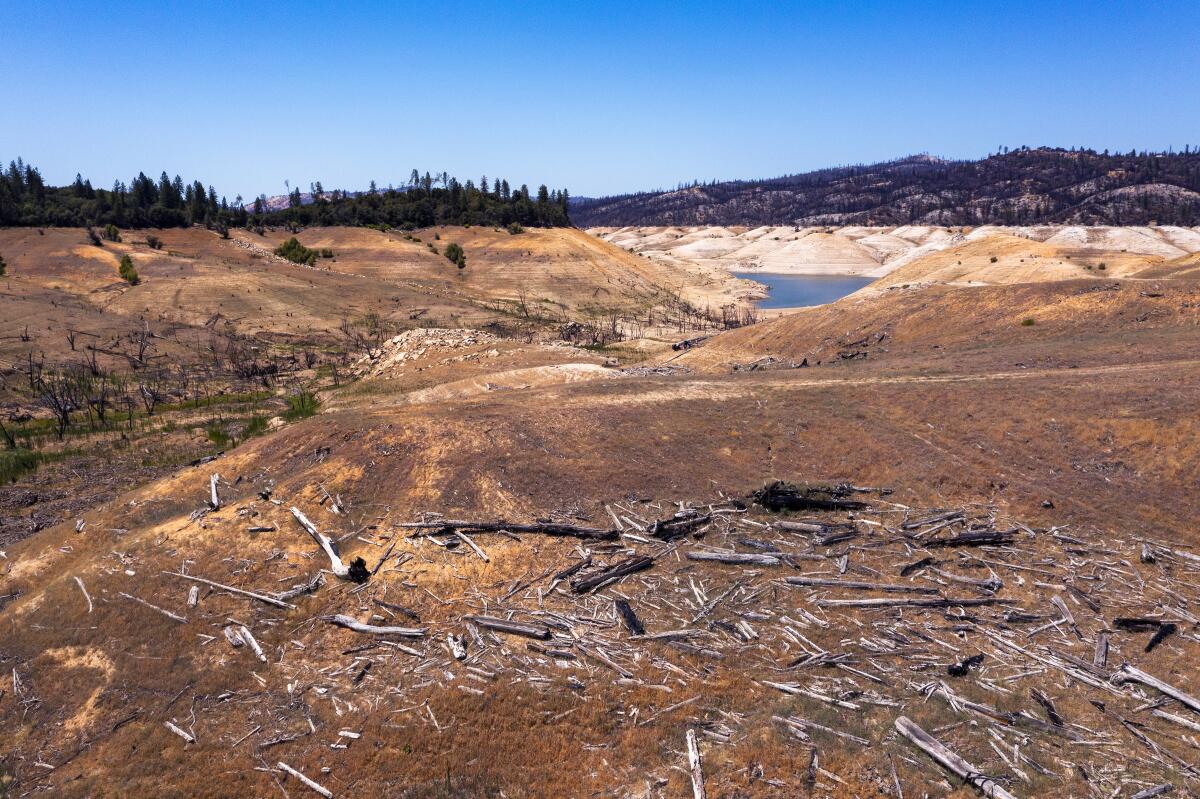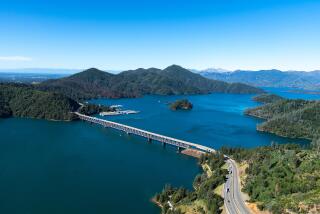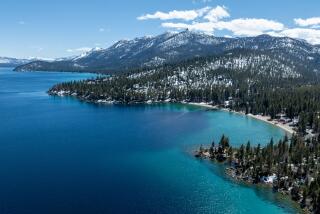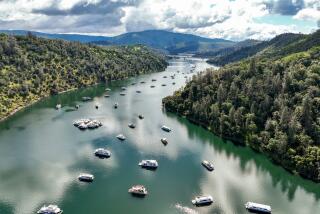Amid worsening drought, Lake Oroville’s record-low water level forces shutdown of hydroelectric power plant

In a sign of the region’s worsening drought, state water officials announced Thursday the shutdown of a major hydroelectric power plant at Lake Oroville in Northern California, citing the lowest-ever recorded water level at the reservoir.
It marks the first time that officials have been forced to close the Edward Hyatt Powerplant, which was completed in 1967, on account of low water at the lake. The loss of the hydroelectric power source at Lake Oroville, about 75 miles north of Sacramento, could contribute to rolling blackouts in the state during heat waves in coming months.
“This is just one of many unprecedented impacts we are experiencing in California as a result of our climate-induced drought,” Karla Nemeth, director of the state Department of Water Resources, said in a statement.
It also marks another humbling moment for the state as it struggles with the grim and compounding effects of climate change. The dam — the tallest in the U.S. — is part of a sprawling system that moves water from the mountains of Northern California to the rest of the state. But the severe drought has diminished that water to a trickle and, now, has cut power generation.
The move to shut down the plant was not unexpected.
Officials had warned that once the water level in Lake Oroville fell to 640 feet above sea level, the plant could no longer produce power; at that level, the water cannot reach the intake pipes that flow toward the underground hydroelectric facility.
On Thursday, Lake Oroville was at 641 feet with 863,516 acre-feet of storage, which is 24% of its overall capacity and 34% of its historical average for this time, according to the Department of Water Resources.
“There’s low and then there’s low. And now it’s gone. It’s a big deal,” said Jim Caldwell, a former assistant general manager at the Los Angeles Department of Water and Power.
The California Independent System Operator, or CAISO — whose job it is to keep electricity supply and demand in balance for most of the state — identified late summer as the period of greatest risk for the state’s hydroelectric supply.
Officials for weeks have sought to mitigate the effect on the power grid. The Hyatt plant is designed to produce up to 750 megawatts of power but has often generated 100 to 400 megawatts, or slightly less than 1% of the state’s average daily peak usage.
“The loss of the plant doesn’t mean there’s going to be more blackouts, but it raises the risk that there will be,” Caldwell said. “It’s like a percent of state’s resources, but we’re tight.”
Caldwell said the loss of the Hyatt plant’s capacity was greater than the shortfall that caused rolling blackouts last summer, and he pointed to the financial effect. Replacing the lost power would cost far more than the hydroelectric power generated at Lake Oroville, and that replaced electricity would probably be less efficient, drive up emissions and deliver more pollution overall.
“It’s a significant event in its own right, and it’s a lot of money: That’s a valuable piece of property for the low-cost electricity it generates,” he said. “And in the context of all the other stuff, it’s a problem.”
The shutoff of the Hyatt plant is a harbinger of drought-driven challenges to the power supply. Last month, the California Energy Commission and Public Utilities Commission reported that drought would reduce the state’s hydropower capacity by about 1,000 megawatts.
And in 2020, in-state hydroelectricity generation plummeted 44.3% from the previous year, the Energy Commission recently reported, part of a 6% total drop over the same time period in electricity from sources that do not release carbon.
That drop was “directly attributable” to lowered hydroelectricity output caused by dry conditions across the state, the commission explained.
The receding water line at Lake Oroville is a dramatic change from 2017, when storms slammed Northern California and filled the lake nearly to capacity. The storms eroded the main and emergency spillways, limiting the reservoir’s main tool to control the water level, which forced thousands of residents below the dam to evacuate.
In recent years, the water level has fallen by more than 250 feet, and this week, it broke a record set in 1977 for the lowest level ever.
Nemeth, the state water official, said her agency plans to focus on preserving “as much water in storage as possible” and release some water from the dam to maintain the Feather River’s temperature requirements.
Times staff writer Julia Wick contributed to this report
More to Read
Sign up for Essential California
The most important California stories and recommendations in your inbox every morning.
You may occasionally receive promotional content from the Los Angeles Times.











